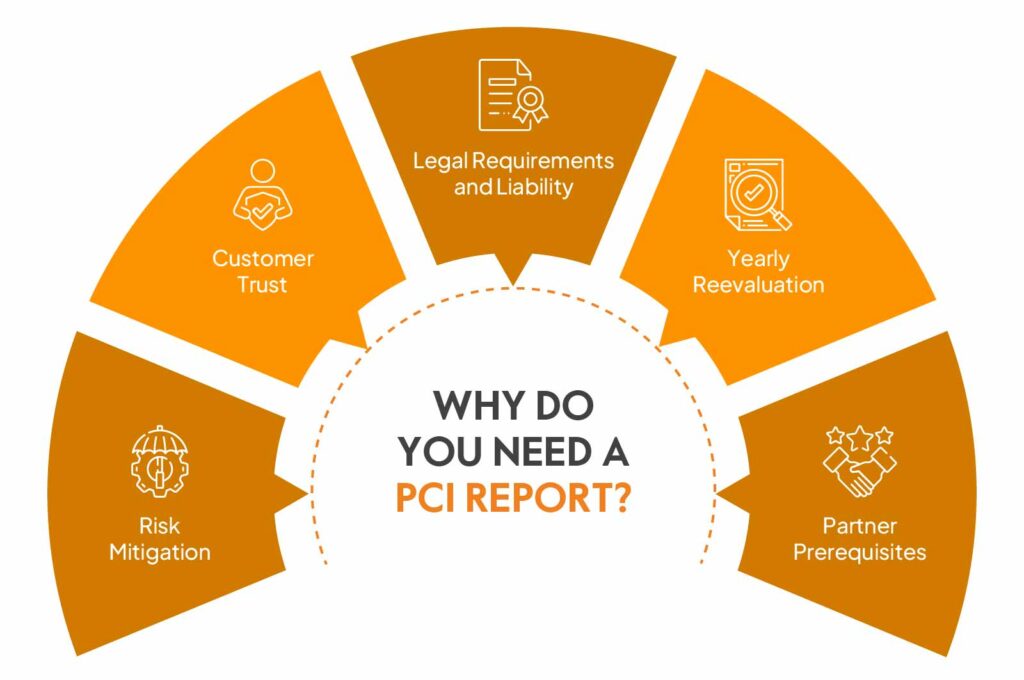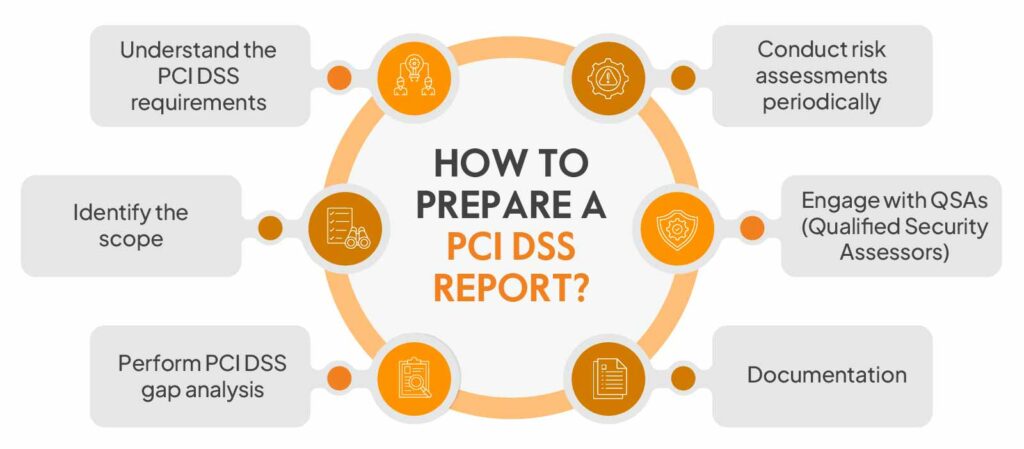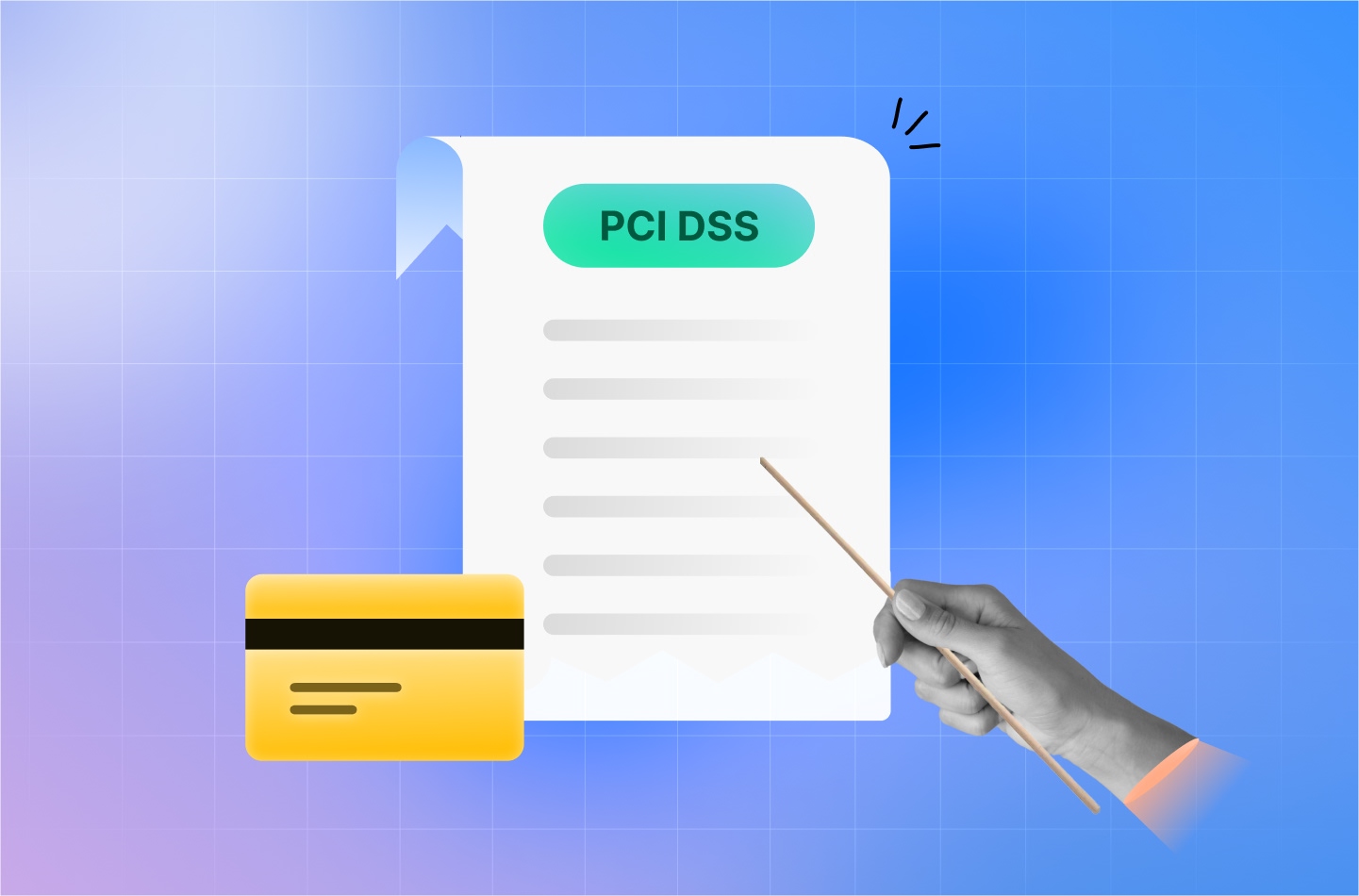If you accept debit or credit cards, you must achieve and maintain PCI Security Standards Council compliance. Any service provider that has the potential to affect the payment security of card transactions is also subject to Payment Card Industry Data Security Standard (PCI DSS).
The PCI report is a cornerstone of this effort, providing an in-depth assessment of an organization’s compliance with the severe security criteria defined by the PCI Security Standards Council.
PCI DSS provides instructions for gathering, handling, and storing sensitive customer data. In order to achieve compliance, it is important to keep a check on the PCI report. A PCI report is made depending on the level of compliance you want to achieve.
In this article, we are going to take a deeper look into the PCI report, its purpose, the elements of this report, and how its created.
What is a PCI report?
A PCI Report is an evaluation of a business’ security measures for protecting cardholder data. The report shows whether your organization meets all 12 standards of the PCI DSS, as well as any faults detected during the inspection.

There are various PCI compliance levels, and each is based on how many transactions an organization does annually. The higher the level, the stricter defenses implemented, and compliance practices must be audited.
- Level 1: Merchants handling more than 6 million card transactions annually.
- Level 2: Merchants that handle between 1 and 6 million transactions yearly.
- Level 3: Merchants that handle 20,000–1 million transactions annually.
- Level 4: Merchants handling under 20,000 transactions annually.
Also check out this video for PCI DSS levels
Depending on the PCI level at which your company operates, the compliance report will be either a RoC or a self-assessment questionnaire (SAQ).
Download the questionnaire below:
Depending on the demands of the credit card brands, RoCs are necessary for Level 1 and Level 2 merchants. For the purpose of this blog, we will call a PCI Report on Compliance (RoC) a PCI report.
A PCI-DSS report is created by a qualified security assessor (QSA) or internal security assessor (ISA) after they have conducted an on-site evaluation of the merchant in accordance with the PCI-DSS criteria.
Compliance is achieved only when a PCI QSA audits the merchant and completes the ROC form. The form is subsequently submitted to the merchant’s acquiring bank. The merchant’s bank transmits the ROC to Visa for compliance verification after it has been approved by the bank.
Overall, creating a PCI report takes more than meets the eye. Just getting ready for the PCI audit takes months, if not years, when things are done manually. However, there are automation solutions, such as Sprinto, which make things easier for you.
With Sprinto, you can get compliance-ready in weeks and give your pre-audit assessment test to ensure you’re on the right track.
Why do you need a PCI report?
PCI reports are necessary for businesses handling payment card data, including retailers, service providers, and financial institutions. However, there are many other situations where you’ll need a PCI report. Here are some of them:

Risk mitigation
Cybercriminals frequently target data from payment cards. Organizations can reduce their risk of financial loss and reputational damage from data breaches and unauthorized access by putting into practice and learning about the measures described in the PCI DSS report.
Customer trust
A PCI report validates that compliance is withheld by the organization. Customers, partners, and stakeholders often take note of that, as it speaks of a good security posture. This also enables the organization to build long-term relationships with other vendors or partners.
Legal requirements and liability
In the event of a data breach, non-compliance with PCI DSS may result in monetary fines, legal repercussions, and reputational harm. PCI reports are used as proof of an organization’s compliance efforts and may be required by regulatory agencies, acquiring banks, or payment card companies.
Yearly reevaluation
PCI compliance is a continuous process. Organizations must undergo annual tests to ensure they continue to meet the security requirements. The PCI report acts as a reference point and compliance status during each assessment.
Partner prerequisites
Many businesses, especially vendors and service providers, may demand that their business partners present proof of PCI compliance. Building and maintaining business ties with such partners may require the provision of PCI reports.
Also, check out: Guide to PCI certification process
What does the PCI report include?
A RoC is divided into two sections: an overview of the evaluation and a summary of the results.

- A brief summary: Gives a summary of the report’s findings regarding the security of cardholder information. This includes significant vulnerabilities, compliance status, and the assessment of security measures.
- Description of the scope and strategy used: Gives information about the network segmentation, payment apps, PCI DSS version utilized throughout the evaluation, and the timeline.
- Vulnerability and risk assessment: Documentation of vulnerability scans, penetration testing, risk assessments, and their outcomes. These examinations help in identifying possible vulnerabilities and threats to cardholder data.
- Detailed Assessment Results: An in-depth analysis of the compliance assessment results, including both good and negative findings (areas of non-compliance or inadequacies).
- Requirement mapping: This section connects each PCI DSS criteria to the specific controls and measures that the organization has put in place to achieve those standards.
- Information about the environment under review: Includes a network segmentation diagram, a description of the cardholder data environment (CDE), service providers, audit interviewees, and pertinent business records.
- Procedures and Policies: An outline of the written rules and processes implemented by the organization to maintain and enforce PCI compliance. This may include policies on access management, data preservation, incident response, and other topics.
- Proof of Compliance: Evidence supporting the implementation and effectiveness of security mechanisms, such as screenshots, logs, configuration files, and other documentation.
- Date of the report and contact information: Includes the merchant and assessor’s contact details as well as the report’s date. The data enables accurate documentation of the inspection process and acts as a record of the individuals and organizations participating in the evaluation.
- Result of a quarterly scan: A rundown of the findings from the last four quarterly scans. These findings generally include vulnerability assessment reports, remediation steps, trend analysis, compliance status, risk rating, etc. Proof of remediation closure is also required to validate that the risks have been resolved.
- Discoveries and observations: An overview of any findings that might not fit in the typical RoC template, along with information on compensating controls. These findings could be connected to specific settings, applications, compensating controls, improvement recommendations, or conditions unique to the organization.
- Attestation of Compliance (AOC): A formal declaration signed by the organization’s upper management confirming the accuracy of the report and saying that the organization is PCI DSS compliant.
Find out more on PCI Attestation of Compliance.
How to prepare a PCI DSS report?
The purpose of preparing for the PCI DSS report is to make the audit process less stressful by lowering the risks of failing the PCI compliance audit.

Here is how you can prepare for the PCI DSS report:
Understand the PCI DSS requirements
It’s crucial that you are up to date on the latest PCI DSS requirements and the standard’s criteria. The standard normally consists of 12 top-level standards and a large number of lower-level requirements that address topics including network security, data protection, access control, vulnerability management, and more.
Identify the scope
Determine the scope of your cardholder data environment (CDE). Find out which networks, systems, and procedures are used for processing, transmitting, or storing cardholder data.
Perform PCI DSS gap analysis
When you are not prepared, the onsite PCI DSS compliance audit procedure can take a while. A QSA can pre-audit your business to assess what you are doing in relation to the specific requirements of PCI DSS and carry out a PCI DSS gap analysis as a starting point in order to be a better and more affordable solution.
Conduct risk assessments periodically
Your change management team should assess a recently implemented system and its potential effects on the current infrastructure. Therefore, you can analyze the same due diligence to ascertain the impact of changes in PCI DSS compliance.
In contrast to PCI audits, risk analysis and assessments let you evaluate and test the effects of system changes on a smaller scale.
Engage with QSAs (Qualified Security Assessors)
Engage a PCI DSS Qualified Security Assessor (QSA) to carry out a formal audit if necessary. The PCI Security Standards Council (PCI SSC) has given QSAs permission to conduct compliance audits and verify your organization’s adherence to the standard.
Also check out: PCI QSA Certification Guide
Documentation
Document all the information required for the audit, including as policies, processes, network diagrams, configuration standards, and proof that the requirements have been met.
Examples of aspects covered in the PCI report
A PCI report points out several instances where the company may not be doing enough to protect cardholder data. These findings may differ depending on the precise assessment, the scale of the company and industry, and the environment in which they accept credit cards.
Here are some typical findings in a PCI report:
Poor encryption
- Failure to encrypt cardholder data during storage and transfer.
- Use of outdated encryption techniques or weak encryption algorithms.
Weak access controls
- Inadequate procedures for authorization and authentication.
- Inadequate password policies, such as using weak passwords or not requiring password expiration.
- Unauthorized access to confidential data and systems.
Improper patch management
- Failure to promptly implement security updates and fixes.
- Outdated applications and operating systems with security holes.
Unsecured network setup
- Faulty firewall, router, and switch configuration.
- Open ports and vulnerable services that are not required.
Unsecured cardholder information:
- Complete magnetic stripe storage, CVV storage, or other sensitive data storage following authorization.
- Improper tokenization or truncation techniques are used.
Here is a sample of a PCI report
Sprinto’s take on PCI DSS and RoC
Now that we have covered what is in a PCI DSS report, it is evident that this compliance is crucial to organizations dealing with cardholder’s data. Sprinto is a compliance automation solution that helps you in getting compliant with PCI DSS.
Sprinto offers time-bound and guided implementation for PCI DSS that enables you to cut down the manual work, time, and resources you’d need to put otherwise. Sprinto generates a pre-audit report for you, making the audit process much easier.
Talk to our experts to see for yourself how Sprinto takes your compliance journey to the next level.
FAQs
Who checks PCI compliance?
Qualified Security Assessors (QSAs), qualified experts authorized by the Payment Card Industry Security Standards Council (PCI SSC) to conduct assessments and audits of organizations’ compliance with PCI DSS, are in charge of evaluating PCI compliance.
What is proof of PCI compliance?
Proof of PCI compliance is a report that shows an organization’s compliance with the PCI DSS requirements and attests to the fact that the organization has put in place the necessary security controls to safeguard cardholder data during payment card transactions.
Can I do PCI compliance myself?
The intricacy and technical requirements associated with PCI compliance can make it difficult to achieve on your own. To ensure full examination and conformity to PCI DSS requirements, it is suggested that you seek the help of qualified experts or use a PCI compliance service provider.
Shivam Jha
Shivam is our in house cybersecurity sage with over six years of experience in cybersecurity under his belt. He is passionate about making the digital world safer for everyone and whipping up Indian delicacies on the weekend.
Explore more
research & insights curated to help you earn a seat at the table.






















